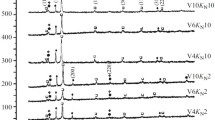Conclusions
-
1.
Tungstenless high-speed powder steels with more than 3% molybdenum contain a coarse carbide phase (up to 6.5 μm) and are prone to growth of austenite grain during heating prior to hardening. This impairs the structure and the strength of the steel, which has a deleterious effect on the operating properties of the tool.
-
2.
Increased content of vanadium to 4.6% helps maintain the disperse carbide phase and reduce the size of the austenite grain during heating prior to hardening. However, steel containg 3.0% V has the same structure.
-
3.
Increasing the molybdenum and vanadium content of steels to more than 3% does not affect their heat resistance because the degree of alloying of the solid solution remains unchanged.
-
4.
Optimal and economically justified is the composition of low alloy tungstenless high-speed steel with a molybdenum and vanadium content of about 3% each, which corresponds to the composition of steel ROM2F3.
Similar content being viewed by others
Literature cited
N. A. Minkevich, Low Alloy High-Speed Steels [in Russian], Metallurgizdat, Moscow (1944).
H. Schrader, "Die Weiterentwicklung der sparstoffarmen Schnellarbeitsstähle und ihre zweckmässige Wärmebehandlung," Stahl und Eisen, No. 40/41, 645–654 (1944).
E. Houdremont and H. Schrader, Technische Mitteilungen Krupp, No. 8, November (1937) (see also: Kachestvennaya Stal', No. 3 (1938)).
A. P. Gulyaev, Low Alloy Tungsten and Molybdenum Containing High-Speed Steels [in Russian], Mashgiz, Moscow-Leningrad (1941).
A. P. Gulyaev, L. P. Sergienko, and E. P. Tolkacheva, "The structure and properties of tungstenless high-speed powder steel ROM2F3-MP," Metalloved. Term. Obrab. Met., No. 5, 37–43 (1985).
A. N. Popandopulo and G. É. Titenskaya, "Prospects of the development of molybdenum high-speed powder steels," Stal', No. 5, 83–84 (1982).
G. G. Mukhin, V. A. Gorelov, and L. P. Korotkova, "Sintered high-speed steel without tungsten," Vestn. Mashinostr., No. 9, 45–46 (1981).
L. S. Kremnev, "Hypereutectoid high-speed steels," Metalloved. Term. Obrab. Met., No. 8, 24–25 (1985).
A. P. Gulyaev, I. K. Kupalova, and V. A. Landa, "Method and results of phase analysis of high-speed steels," Zavod. Lab.,31, No. 3, 298–318 (1965).
Additional information
I. P. Bardin Central Research Institute of Ferrous Metallurgy. Translated from Metallovedenie i Termicheskaya Obrabotka Metallov, No. 2, pp. 26–30, February, 1986.
Rights and permissions
About this article
Cite this article
Gulyaev, A.P., Sergienko, L.P. Effect of molybdenum and vanadium on the structure and properties of tungstenless high-speed powder steel. Met Sci Heat Treat 28, 112–118 (1986). https://doi.org/10.1007/BF00717531
Issue Date:
DOI: https://doi.org/10.1007/BF00717531




